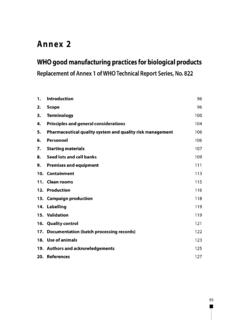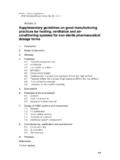Transcription of EU GMP Annex 1 Update 2008 Airborne Particle Counting
1 TECHNICAL PAPEREU GMP Annex 1 Update 2008 Airborne Particle CountingVersion 01. Rev 01. 03/312008 Airborne Particle Counting for pharmaceutical Facilities: Update 2008 , EU GMP Annex 1 Lighthouse Worldwide SolutionsOn February 14th, 2008 , The European Commission updated Volume 4 EU Guidelines to good manufacturing Practice Medicinal Products for Human and Veterinary Use, Annex 1: Manufacture of sterile Medicinal Update come s into operation on March 1st, 2009.(With the provisions on capping of freeze dried vials implemented by March 1st, 2010) Cleanroom and Clean Air Device Classification: The formal cleanroom testing for classification should be done per the EN ISO 14644-1 key point stated in this Update is that classification should be clearly differentiated from the operational process of environmental monitoring.
2 The maximum permitted Airborne Particle concentration is given in table 1. Table 1: Updated limits in Particle counts per Grade. Maximum permitted number of particles per m3 equal to or greater than the tabulated sizeAt restIn mA3,520 20 3,520 20 B3,520 29 352,000 2,900 C352,000 2,900 3,520,000 29,000 D3,520,000 29,000 Not defined Not defined Comparison Annex 1, to ISO 14644-1 To note the Particle Classifications are NOT Exactly per ISO 14644-1, but the amount of difference is listed in Table 2 for Grades C and D (note areas in BOLD) 20080331-1A Table 2 At 1 ISO14644-1(Class) CountAnnex 1 ISO14644-1(Class) CountAnnex 1 ISO14644-1(Class) CountAnnex 1 ISO14644-1(Class)
3 CountA3,520 (5) 3,52020( ) 203,520(5) 3,520 20( ) 20B3,520 (5) 3,52029(5) 29352,000 (7) 352,000 2,900 (7) 2,930C352,000 (7) 352,000 2,900 (7) 2,9303,520,000 (8) 3,520,000 29,000 (8) 29,300D3,520,000 (8) 3,520,000 29,000 (8) 29,300 Not DefinedNot DefinedFor cleanroom certification testing of Grade A zones, a minimum sample volume of 1m3should be taken per sample location. It should be noted that this follows the sampling guidelines of EN ISO 14644-1. For Grade A, the Airborne Particle classification is *ISO and is dictated by the limit for particles 5.
4 0 m , which is 20 particles per cubic meter. *(EN ISO 14644-1 allows intermediate classifications with the minimum increment of ) For Grade B (at rest) the Airborne Particle classification is ISO 5 for both Particle sizes and in operation, the Airborne Particle classification is ISO 7 for both Particle sizes. For Grade C at rest, the Airborne Particle classification is ISO 7 and in operation the Airborne Particle classification is ISO 8. For Grade D (at rest) the Airborne Particle classification is ISO 8 and it is not defined for in operation. For the classification of a cleanroom or clean air device, EN/ISO 14644-1 defines.
5 The minimum number of sample locations The sample size (volume) based on the class limit of the largest Particle size under consideration The means of evaluating the data 20080331-1A Minimum Number of Sample LocationsThe minimum number of sample locations for cleanroom certification testing per EN ISO 14644-1 is a simple calculation NL= AWhere NL is the minimum number of sample locations (rounded up to the nearest whole number), and A is the area of the cleanroom or clean zone in square meters. Minimum Sample Size (Volume) The minimum sample volume for cleanroom certification testing per EN ISO 14644-1 is determined by largest considered Particle size for that particular environment.
6 The Grade A environment at m is classified as an ISO cleanroom or clean air device. This is where the 1 cubic meter of air / location comes from. EN ISO 14644-1 states that, for each sample location, sample a sufficient volume of air that a minimum of 20 particles would be detected if the Particle concentration for the largest considered Particle size were at the class limit for the designated ISO Class. The Sample volume or Vs per location is determined by the equation below: Where : Vs is the minimum single sampling volume per location, expressed in liters C n,m is the class limit (number of particles per cubic meter) for the largest considered Particle size, specified for the relevant class.
7 20 is the defined number of particles that could be counted if the Particle concentration were at the class limit. (See EN ISO 14644-1 Section for details) Per ISO 14644-1 the minimum sample volumes for each of the Grade areas in liters is listed in Table 3, based upon the largest considered Particle size. Table 3 At Rest In Operation GradeMinimum Sample VolumeMinimum Sample VolumeA1000 1000 B690 *7C*7*2D*2 Not defined*the volume sampled at each location shall be at least 2 liters, with a minimum sampletime of 1 The minimum sample volume presents an unusual situation where the minimum number of sample locations is 1.
8 Per EN ISO 14644-1 where only one sampling location is required, take a minimum of three single sample volumes at that location. For a small Grade A environment where only one sample location is needed, a minimum of 3 cubic meters of air must be tested (see EN ISO 14644-1 Annex B for details). For the classification testing, portable Particle counters with a short length of sample tubing should be used. This requirement exists because of the loss of large sized particles ( m) in the sample tubing. Though not clearly stated in Annex 1, Lighthouse Worldwide Solutions recommends keeping the length of this tube (when possible) to less than 3 meters.
9 Isokinetic sample probes must be used in unidirectional airflow systems. Lighthouse Worldwide Solutions recommends using an isokinetic probe in non-unidirectional airflow systems as well. The in-operation classification may not always be possible during normal operations. This classification may be demonstrated in simulated operations, during media fills or normal operations. Demonstrating Continued Compliance In order to demonstrate continued compliance, EN ISO 14644-2 provides information on this testing. The frequency of such testing is in the Table 4. Table 4 A and B cleanrooms or clean air devices must be re-tested every 6 months.
10 Grade C and D must be recertified at a minimum of every year. Cleanroom and Clean Air Device Monitoring: Particle monitoring during the operational process is different from the Particle monitoring for classification of the environment. All Grade environments should be routinely monitored while they are in operation. The locations selected for this Particle monitoring should be chosen based upon a formal risk analysis and the results taken during the cleanroom classification testing of the cleanroom or clean air device. Grade A Particle Monitoring 20080331-1A eu_gmpIn Grade A zones, Particle monitoring should be done during the entire operation of a critical process, including equipment assembly aand setup exceptions are where the contaminates in the process would damage the Particle counter or present a hazard.




